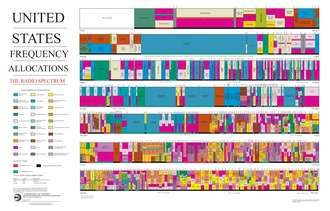Frequency allocation

Frequency allocation (or spectrum allocation) is the division of the electromagnetic spectrum into radio frequency bands. This spectrum management is regulated by governments in most countries.[1] Radio propagation does not stop at national boundaries. Giving technical and economic reasons, governments have sought to harmonise the allocation of RF bands and their standardization.
ITU definition
The International Telecommunication Union[2] – defines frequency allocation as being of "a given frequency band for the purpose of its use by one or more terrestrial or space radiocommunication services or the radio astronomy service under specified conditions".
Frequency allocation is also a special term, used in national frequency administration. Other terms are:
| Frequency distribution to: |
ITU languages | ITU RR (article) | |||||
| French | English | Spanish | Arabic | Chinese | Russian | ||
|---|---|---|---|---|---|---|---|
| Radiocommunication services | attribution (attribuer) |
allocation (to allocate) |
attribucion (attribuir) |
распределение (распределять) |
1.16 | ||
| Regions or countries | allotisement (allotir) |
allotment (to allot) |
adjudication (adjudicar) |
выделение (выделять) |
1.17 | ||
| Radio stations | assignation (assigner) |
assignment (to assign) |
asignacion (assignar) |
присвоение (присваивать) |
1.18 | ||
Bodies
A number standards bodies work on standards for frequency allocation, including:
- International Telecommunication Union (ITU)
- European Conference of Postal and Telecommunications Administrations (CEPT)
- Inter-American Telecommunication Commission (CITEL)
In order to improve harmonisation in spectrum utilisation, the majority of service-allocations stipulated in this document were incorporated in national Tables of Frequency Allocations and Utilisations which is with-in the responsibility of the appropriate national administration. The allocation might be primary, secondary, exclusive, and shared.
- primary allocation: is indicated by writing in capital letters (see example below)
- secondary allocation: is indicated by small letters
- exclusive or shared utilization: is within the responsibility of administrations
However, military usage, in bands where there is civil usage, will be in accordance with the ITU Radio Regulations. In NATO countries military mobile utilizations will be in accordance with the NATO Joint Civil/Military Frequency Agreement (NJFA).
Example
| Allocation to services | ||
| Region 1 | Region 2 | Region 3 |
| 135.7–137.8 kHz |
135.7–137.8 kHz
|
135.7–137.8 kHz
|
See also
References
- ↑ Haim, Mazar (2008-08-01). An Analysis of Regulatory Frameworks for Wireless Communications, Societal Concerns and Risk: The Case of Radio Frequency (RF) Allocation and Licensing (PDF). Middlesex University.
- ↑ ITU Radio Regulations, Section IV. Radio Stations and Systems – Article 1.16, definition: allocation (of a frequency band)
External links
- International Telecommunication Union (ITU)
- ITU Radio Regulations - Volume 1 (Article 5) international table of frequencies by ITU Region